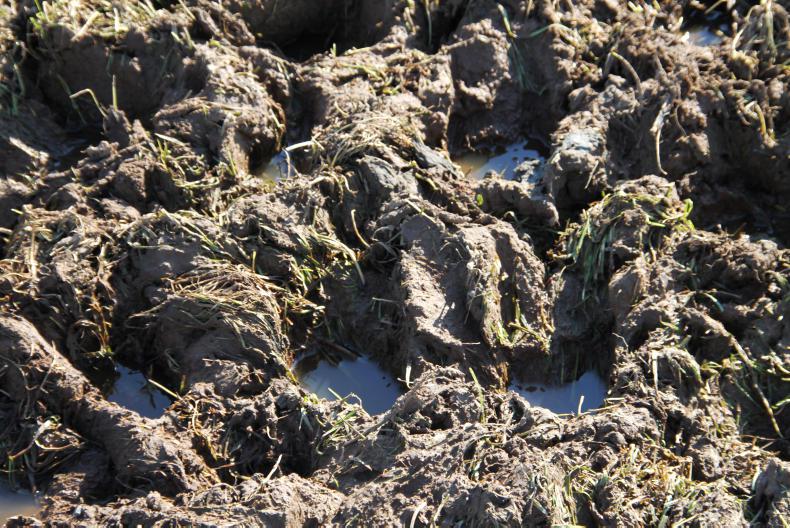It’s a highly emotive topic and farmers have a general fear of the inspection process, but farmers shouldn’t worry about having an inspection.
In a lot of cases, there are no problems and farmers don’t incur any penalties, but it can be stressful getting through it sometimes.
This was the message from regional inspector with the Department of Agriculture Mairead Fanning, speaking at a beef seminar organised by Teagasc's Tery Carroll in Kilkenny on Thursday night.
What is cross compliance?
In 2005, Ireland moved to a decoupled payment system for headage and subsidies and linked the new payment system to compliance with environmental issues and laws.
The Single Farm Payment package is worth €1.6bn to Ireland and farmers in receipt of this money must be compliant.
It was thought that with decoupled payments, land may not be farmed as intensively and this could lead to encroachment, so good agricultural and environmental condition (GAEC) measures were also brought in to form cross compliance.
There are 13 statutory management requirements (SMRs) and 7 GAEC measures.
How many inspections take place each year?
The EU dictates every year how many inspections are to take place. If the required number of inspections don’t take place, Ireland is fined and operates with a reduced budget.
Cattle inspections are the most likely inspection that farmers can be selected for in 2020, with 3,600 of these inspections to take place, while 1,400 cross compliance inspections will also take place in 2020.
Table 1 outlines the percentage of inspections that will take place in different schemes in 2020
How are people selected for inspection?
A lot of the selection process is determined by risk analysis. What this means is, if you have had a BPS penalty in the past, you are highly likely to get selected for another inspection in the years following the penalty.
Late calf registration, late notification of animal movements or late sheep census returns will all increase the likelihood of getting an inspection, but 20% to 25% of inspected farms will be selected at random.
Do I get notice?
Full cross compliance inspections are unannounced. There are elements of the full cross compliance inspection that can be deferred.
All other inspections - including cattle, sheep, eligibility inspections, BDGP, BEEP, young farmer scheme and Sheep Welfare Scheme - will generally get 48 hours’ notice of inspection.
When will inspections take place in 2020?
Nitrates inspections are started in January and take place during the closed period for the particular county. Cattle, sheep and land inspections take place throughout the year.
Land eligibility inspections need to take place before the ANC payment run in September. For land eligibility inspections, 90% of these are carried out remotely and 10% carried out on the ground, so, for many people, unless there is a problem, they will never know they had an inspection.
BDGP, BEEP and Sheep Welfare Scheme inspections take place from September to December. Young farmer scheme inspections are carried out in January to March each year.
Nitrates derogation inspections are started after 15 May (BPS closing date). GLAS inspections are carried out in the second half of each year.
What area has the most penalties?
The SMRs that cause most problems include:
Nitrates – for example inadequate collection of livestock manures accounted for 33% of penalties. Failure to minimise soiled water accounted for 19% of penalties.GAEC – for example poaching, noxious weeds, encroachment, removal of landscape features.Bovine identification and registration (IDR) – for example, tags missing, registration and notification issues. Tagging accounted for 62% of breaches under this category. Issues with the AIMS database accounted 18% of penalties in this section also.Ovine identification and registration – for example tags missing, flock register and dispatch dockets issues and census errors.Records are required for a number of SMRs, including animal remedies, pesticide application records, flock/herd registers, fertiliser and feed receipts.
It’s important that these records are kept safe on farm for inspection.
GAEC issues
Removing landscape features was the biggest area of non-compliance under this measure accounting for 27% of penalties.
These were hedges, tress in line, habitats or archaeological features.
Failure to prevent encroachment accounted for 24% of penalties. Severe poaching accounted for 22% of penalties, while evidence of poaching/rutting accounted for 21% of penalties.
Cutting hedges during the nesting season accounted for 2% of penalties in 2017.
Land eligibility
Eligible land is the primary requirement for many EU payment schemes. It’s important to declare all of the land you farm. Under-declaration can result in a penalty.
Land must be agricultural land and maintained in a state suitable for grazing or cultivation. You have a choice of:
(i) Production, rearing or growing of agricultural products, including harvesting, milking, breeding animals, and keeping animals for farming purposes; or
(ii) Using other means to maintain an agricultural area in a state which makes it suitable for grazing or cultivation, for example topping.
During a land eligibility inspection, the inspector will walk all parcels and check:
Parcel boundaries are correct.Ineligible features are deducted.Checks for farming activity and abandonment.Some of the main issues found on inspection include:
No deductions made for ineligible features particularly on marginal type land; and/orInsufficient deductions made for ineligible features eg rivers, farmyards, roadways, scrub, rocky outcrops etc; and/orIncorrect parcel boundaries. Read more
Camera at the Mart: strong demand and prices for stores and cows
Lifetime assurance planned for 2023
Farm animal welfare complaints decline in NI
It’s a highly emotive topic and farmers have a general fear of the inspection process, but farmers shouldn’t worry about having an inspection.
In a lot of cases, there are no problems and farmers don’t incur any penalties, but it can be stressful getting through it sometimes.
This was the message from regional inspector with the Department of Agriculture Mairead Fanning, speaking at a beef seminar organised by Teagasc's Tery Carroll in Kilkenny on Thursday night.
What is cross compliance?
In 2005, Ireland moved to a decoupled payment system for headage and subsidies and linked the new payment system to compliance with environmental issues and laws.
The Single Farm Payment package is worth €1.6bn to Ireland and farmers in receipt of this money must be compliant.
It was thought that with decoupled payments, land may not be farmed as intensively and this could lead to encroachment, so good agricultural and environmental condition (GAEC) measures were also brought in to form cross compliance.
There are 13 statutory management requirements (SMRs) and 7 GAEC measures.
How many inspections take place each year?
The EU dictates every year how many inspections are to take place. If the required number of inspections don’t take place, Ireland is fined and operates with a reduced budget.
Cattle inspections are the most likely inspection that farmers can be selected for in 2020, with 3,600 of these inspections to take place, while 1,400 cross compliance inspections will also take place in 2020.
Table 1 outlines the percentage of inspections that will take place in different schemes in 2020
How are people selected for inspection?
A lot of the selection process is determined by risk analysis. What this means is, if you have had a BPS penalty in the past, you are highly likely to get selected for another inspection in the years following the penalty.
Late calf registration, late notification of animal movements or late sheep census returns will all increase the likelihood of getting an inspection, but 20% to 25% of inspected farms will be selected at random.
Do I get notice?
Full cross compliance inspections are unannounced. There are elements of the full cross compliance inspection that can be deferred.
All other inspections - including cattle, sheep, eligibility inspections, BDGP, BEEP, young farmer scheme and Sheep Welfare Scheme - will generally get 48 hours’ notice of inspection.
When will inspections take place in 2020?
Nitrates inspections are started in January and take place during the closed period for the particular county. Cattle, sheep and land inspections take place throughout the year.
Land eligibility inspections need to take place before the ANC payment run in September. For land eligibility inspections, 90% of these are carried out remotely and 10% carried out on the ground, so, for many people, unless there is a problem, they will never know they had an inspection.
BDGP, BEEP and Sheep Welfare Scheme inspections take place from September to December. Young farmer scheme inspections are carried out in January to March each year.
Nitrates derogation inspections are started after 15 May (BPS closing date). GLAS inspections are carried out in the second half of each year.
What area has the most penalties?
The SMRs that cause most problems include:
Nitrates – for example inadequate collection of livestock manures accounted for 33% of penalties. Failure to minimise soiled water accounted for 19% of penalties.GAEC – for example poaching, noxious weeds, encroachment, removal of landscape features.Bovine identification and registration (IDR) – for example, tags missing, registration and notification issues. Tagging accounted for 62% of breaches under this category. Issues with the AIMS database accounted 18% of penalties in this section also.Ovine identification and registration – for example tags missing, flock register and dispatch dockets issues and census errors.Records are required for a number of SMRs, including animal remedies, pesticide application records, flock/herd registers, fertiliser and feed receipts.
It’s important that these records are kept safe on farm for inspection.
GAEC issues
Removing landscape features was the biggest area of non-compliance under this measure accounting for 27% of penalties.
These were hedges, tress in line, habitats or archaeological features.
Failure to prevent encroachment accounted for 24% of penalties. Severe poaching accounted for 22% of penalties, while evidence of poaching/rutting accounted for 21% of penalties.
Cutting hedges during the nesting season accounted for 2% of penalties in 2017.
Land eligibility
Eligible land is the primary requirement for many EU payment schemes. It’s important to declare all of the land you farm. Under-declaration can result in a penalty.
Land must be agricultural land and maintained in a state suitable for grazing or cultivation. You have a choice of:
(i) Production, rearing or growing of agricultural products, including harvesting, milking, breeding animals, and keeping animals for farming purposes; or
(ii) Using other means to maintain an agricultural area in a state which makes it suitable for grazing or cultivation, for example topping.
During a land eligibility inspection, the inspector will walk all parcels and check:
Parcel boundaries are correct.Ineligible features are deducted.Checks for farming activity and abandonment.Some of the main issues found on inspection include:
No deductions made for ineligible features particularly on marginal type land; and/orInsufficient deductions made for ineligible features eg rivers, farmyards, roadways, scrub, rocky outcrops etc; and/orIncorrect parcel boundaries. Read more
Camera at the Mart: strong demand and prices for stores and cows
Lifetime assurance planned for 2023
Farm animal welfare complaints decline in NI






 This is a subscriber-only article
This is a subscriber-only article










SHARING OPTIONS: